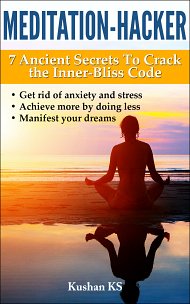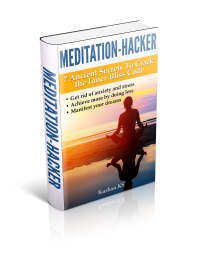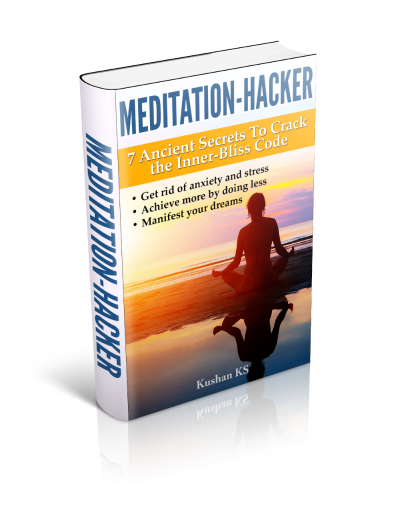Zazen Meditation - To Know the Mind is Empty is to See the Buddha
"When the conditions are conducive, meditation occurs spontaneously" - Zen saying

Za refers to 'sitting' or 'to sit' and zen refers to meditation, and hence zazen meditation literally means 'seated meditation.'
It is the foundation of Zen Buddhist practice, progressing from Concentration to Koan study to Shikantaza (silent illumination or 'just sitting').
The Zazen journey starts with the right posture.
Zen meditators believe that the pyramid structure of the seated Buddha is the most effective posture for the practice of Zazen meditation.
A zafu (small pillow) and a zabuton (rectangular cushion) are utilized to get a stable position of the body. While the zafu raises the behind a little and helps in keeping the spine straight, the zabuton provides support for the knees making the lower body act like a tripod for the seated posture.
There are different leg positions one can sit in:
- Burmese: cross your legs with both feet resting on the floor in front of you. Knees should also rest on the floor, but you may find it difficult to do in the beginning due to stiff muscles.
- Half-lotus: right foot is placed on the left thigh and left leg is tucked under or vice-versa.
- Full-lotus: each foot is placed on the opposite thigh. This is the most symmetrical and stable position and also the most difficult.
- Seiza position: Kneeling position with buttocks resting on upturned feet that form a natural pillow. You could also use a meditation bench that keeps the body weight off your legs and helps to keep your spine straight.
- Chair position: Sit straight on a chair with feet flat on the floor.
Master Dogen, the founder of Soto Zen tradition of Japan, recommended only the half-lotus and full-lotus sitting positions.
According to him sitting in full-lotus was a meditation by itself with nothing more left to be done. It was an interesting way of cautioning his followers to remove the dichotomy between body and mind while approaching meditation.
(How to do the lotus posture without numb painful legs)
You can choose whatever leg position you find most comfortable.
Ultimately, Zazen is not about the feet and legs, it's about the mind.
Though you may exercise freedom in choosing a suitable sitting posture, you will have to follow some pretty specific instructions in other areas:
Breathing should be from the nose, so you have to keep your mouth closed with your tongue touching the palette just behind the teeth.
Eyes should be lowered to gaze at a point two or three feet in front of you - they are neither fully shut nor fully open, so that the meditator is neither distracted by nor turning away from external stimuli.
Hands should be folded in front, around the belly. One hand lying on top of the other with palms facing upward and the two thumbs touching each other lightly. You can rest the arms on your legs for support.
Breathe from your belly with your tummy moving out with every inhalation and collapsing gently with each exhalation.
Focus your attention on the hara, which is situated two inches below your navel.
According to Zen buddhists, hara is the physical and spiritual centre of the body. Imagine your breath reaching the hara upon inhalation and returning from the same point during exhalation.
- Joriki
This first stage in Zazen mediation is one of concentration on the breath, aided by counting or chanting of mantra.
Every time the mind wanders, bring it back to the breath and re-start the count.
This is a powerful first step in gaining back control over your mind and telling it what to do, when to do it and for how long.
The power of concentration is called joriki and, when firmly established, allows the practitioner to move to koan inspection and Shikantaza.
- Koans
In koan study, the object of meditation is a koan.
Since a koan is impossible to solve by intellectual reasoning, the practitioner is forced to continually introspect on the problem posed by the koan and arrive at its answer through direct realization, thus by-passing all mental and logical processes.
- Shikantaza
Finally, Shikantaza is the Zazen meditation practice of simply staying aware in the present moment.
There is no object of meditation and nothing to focus on.
Just clear, present awareness of all things inside and outside.
A monastic setting makes it easy for the individual to adhere to the rigorous requirements of Zazen meditation and derive maximum benefit from it.
This shouldn't discourage you from trying the meditation at home. If it appeals to you, follow up with a week-long meditation retreat to delve deeper and strengthen the practice.
Return from Zazen Meditation to Types of Meditation
Return from Zazen Meditation to Home

Get my book, Meditation-Hacker: 7 Ancient Secrets to Crack the Inner-Bliss Code and receive valuable information on meditation that you can use to improve the quality of your health and life.


Comments
I would love to hear your meditation experiences. And, if you are a beginner, your questions and apprehensions about meditation. Comment below or contact me directly through the navigation bar on the left of this page.